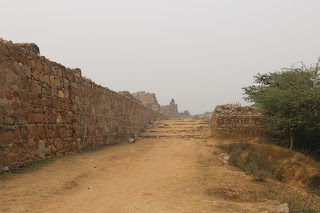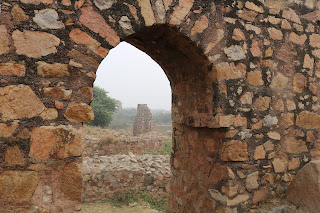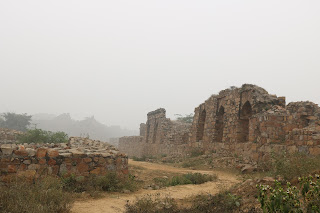While crossing the Badarpur -Mehrauli road my attention rest on the giant wall but never get an opportunity to visit inside. Always curious to know in details about the story that laid behind the most haunted fort of Muslim period of India.All of sudden one day as per planning I got an offer to go inside the fort. It was the foggy and cold winter day of Christmas. I reached as per scheduled time . And I progressed gradually to explore in details about Tughalaqabad Fort.
The founder of Tughlaq Dynasty was Ghiasuddin Tughlaq. Later it was subsequently carried by Muhammad Bin Tughlaq and Firozshah Tughlaq.
Questions a rised in my mind after going through the massive wall of fort that was completed by Ghiasuddin. Why did he took so difficult task for making such a wall around his fort? Though Ghiasuddin was not at all an emperor rather he was a competent commandant under Mubbarak Khilji, the last emperor of Khilji dynasty.As North Western areas were always threatened by the mongols so it required strong protection .Gajji Mallick effectively dealt with this . One day Gajji Mallick and Mubbarack Khilji were riding through a hilly terrain. All of sudden Mallick requested Khilji emperor to build a grand palace there. But, he told him , when you would be a king then built as per your wish on that particular area. Then , luck played a twist game Gajji Mallick got an opportunity to establish himself as a ruler of Delhi and named himself as Ghiasuddin Tughlaq. He established himself as a founder of Tughlaq dynasty on 1321AD .Then, within 2 years of his coronation on the throne of new Tughlaq Dynasty he built all.The.fifth most important city grew at the history of Delhi.
First of all , it was important to know more about the giant wall of the fort. It was so high because to protect from the dangerous threatening from the daunting mongols. Three layers of loop wholes were there to defend the enemies. The surface of walls were not smooth and it was basically very sloppy.Thick of the wall was 10meters., height was 30 meters.
Unevenly stone were placed with lime mortar to stand that wall. Though fort had 52 gates , now only 13 gates remains to get inside the fort. The existence of Hathi Gate, Dhobi& Dhoban Gate, Andheri Gate, Chakhlakhan Gate are prominently giving ideas regarding the lost gates of bygone eras.The sky high walls , double story bastions made it more specific in the 14th century.
My curiosity increased by the time I reached at a Baoli. Water reservoir was an important part of the Tughlaq dynasty.I watched at least 7 to 8 tanks within the citadel areas.These were all stepwell to reserve water.
While moving forward a great reservoir came in front of me. The staircase upto the lowering portion of well was built very strongly. It was very huge and surprisingly not completed. That was the point for which tussle started between a Sufi Saint Hajrat Nizamuddin and Tughlaq ruler Ghiasuddin. Story began like this. When Ghiasuddin started to dig a stepwell or boali then at the same time Sufi saint also decided to dig a pond near his own meditation areas. While the king wanted all laborers to do his work within the fort then nobody's had that power to disobey the order of the king. Ultimately, laborers decided to continue work for saint in the night shift. Even this activities enraged to king and thats why he stopped to supply the oil after the dusk time so that the labourers could not continue their work at dark night. Soon, Sufi Auliya used his supreme power for giving light and by that way his work continued. That activities of Holy Man did not give solace to Ghiasuddin. He totally stopped all the workers and gave order to continue work only for him. And, then He left to west bengal . Ghiasuddin again told his followers that once he would reach at Delhi then he could find the rest of the matter. Immediately, Sufi Saint marked his voice -'Delhi is yet far'. Delhi abhi bahut dur hai......Then ultimately Auliya cursed to the emperor Ghiasuddin-YA RAHE HISSAR, YA BASSEY GUJJAR....MAY THE FORT REMAIN UNOCCUPIED OR ELSE MAY HERDSMEN LIVE...Later, Ghiasuddin never reached upto the gate of Delhi. His son Muhammad bin Tughlaq had arranged a great stage to welcome his father. When Ghiasuddin went towards the central stage, the stage collapsed immediately. He died within 4 years of his rule and he never reached Delhi. It was said that , it was a plan to kill Ghiasuddin so that Muhammad bin tughlaq could fulfill his dream to ascend the throne of Tughlaq dynasty.He also could not stay there for longer time. He made an another fort at Adilabad for himself. It was told that the curse of Saint ultimately fell on their dynasty. The great fort was abandoned at 1327 AD.
I did not resist my temptation to move eastern side of the fort. Though it was difficult to walk within the hilly terrain and thorny bushes. I saw only massive ruins throughout the forts. Few animals were grazing there.
I saw a numbers of granaries that were built under the surface.Ibanbatuta, the Morrocan Traveller , who stayed at Delhi for 4 years. He vividly explained all about the life of people and Tughalaqabad. It was a matter of astonishment to see such a.huge granaries that royal dynasty made for the storage of crops.Even , it was explained that huge amount of grains were drained from the graneries at the time of Balban.
I moved forward and reached an open ground towards the north . A series of courtyards were there. Though all were in ruins stage now still we can imagine from that ruins how big palaces were there. The existence of great gateways gave an idea of the entrance gate of royal members upto the fort.Diwan-i-am & Diwan-i -khas were two most important features of palaces.
Absolutely crazy to cover all other points of fort I reached to glance the dongeons of fort. It were very specifically built at the time of Tughlaq ruler. Historian Sams Siraj mentioned that once a man did not find his way for 3days to come out. The purpose of making such dongeons were the store house of royal belongings.
Then , the great Jahanuma Tower , from there one can see the view around the Tughalaqabad from higher point.
The remains of grand palace, gigantic towers, double story bastons, , splendid mosque within the premises of Great Fort of Ghiasuddin who built it with great dream and high ambition did not stay for long rather it was cursed and still in the same abandoned place since 14th century regardless of many changes in the Medieval History of India. He left an unending spirit of courage and great statesmanship in the page of History to learn more.
It was indeed a mesmerising experince to explore the most haunted fort of delhi.....Great Tughalaqabad Fort.
The founder of Tughlaq Dynasty was Ghiasuddin Tughlaq. Later it was subsequently carried by Muhammad Bin Tughlaq and Firozshah Tughlaq.
Questions a rised in my mind after going through the massive wall of fort that was completed by Ghiasuddin. Why did he took so difficult task for making such a wall around his fort? Though Ghiasuddin was not at all an emperor rather he was a competent commandant under Mubbarak Khilji, the last emperor of Khilji dynasty.As North Western areas were always threatened by the mongols so it required strong protection .Gajji Mallick effectively dealt with this . One day Gajji Mallick and Mubbarack Khilji were riding through a hilly terrain. All of sudden Mallick requested Khilji emperor to build a grand palace there. But, he told him , when you would be a king then built as per your wish on that particular area. Then , luck played a twist game Gajji Mallick got an opportunity to establish himself as a ruler of Delhi and named himself as Ghiasuddin Tughlaq. He established himself as a founder of Tughlaq dynasty on 1321AD .Then, within 2 years of his coronation on the throne of new Tughlaq Dynasty he built all.The.fifth most important city grew at the history of Delhi.
First of all , it was important to know more about the giant wall of the fort. It was so high because to protect from the dangerous threatening from the daunting mongols. Three layers of loop wholes were there to defend the enemies. The surface of walls were not smooth and it was basically very sloppy.Thick of the wall was 10meters., height was 30 meters.
Unevenly stone were placed with lime mortar to stand that wall. Though fort had 52 gates , now only 13 gates remains to get inside the fort. The existence of Hathi Gate, Dhobi& Dhoban Gate, Andheri Gate, Chakhlakhan Gate are prominently giving ideas regarding the lost gates of bygone eras.The sky high walls , double story bastions made it more specific in the 14th century.
My curiosity increased by the time I reached at a Baoli. Water reservoir was an important part of the Tughlaq dynasty.I watched at least 7 to 8 tanks within the citadel areas.These were all stepwell to reserve water.
I did not resist my temptation to move eastern side of the fort. Though it was difficult to walk within the hilly terrain and thorny bushes. I saw only massive ruins throughout the forts. Few animals were grazing there.
I saw a numbers of granaries that were built under the surface.Ibanbatuta, the Morrocan Traveller , who stayed at Delhi for 4 years. He vividly explained all about the life of people and Tughalaqabad. It was a matter of astonishment to see such a.huge granaries that royal dynasty made for the storage of crops.Even , it was explained that huge amount of grains were drained from the graneries at the time of Balban.
I moved forward and reached an open ground towards the north . A series of courtyards were there. Though all were in ruins stage now still we can imagine from that ruins how big palaces were there. The existence of great gateways gave an idea of the entrance gate of royal members upto the fort.Diwan-i-am & Diwan-i -khas were two most important features of palaces.
Absolutely crazy to cover all other points of fort I reached to glance the dongeons of fort. It were very specifically built at the time of Tughlaq ruler. Historian Sams Siraj mentioned that once a man did not find his way for 3days to come out. The purpose of making such dongeons were the store house of royal belongings.
Then , the great Jahanuma Tower , from there one can see the view around the Tughalaqabad from higher point.
The remains of grand palace, gigantic towers, double story bastons, , splendid mosque within the premises of Great Fort of Ghiasuddin who built it with great dream and high ambition did not stay for long rather it was cursed and still in the same abandoned place since 14th century regardless of many changes in the Medieval History of India. He left an unending spirit of courage and great statesmanship in the page of History to learn more.
It was indeed a mesmerising experince to explore the most haunted fort of delhi.....Great Tughalaqabad Fort.


































































